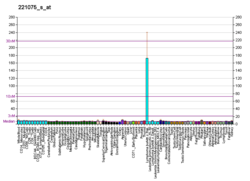| NCR2 | |||||||||||||||||||||||||||||||||||||||||||||||||||
|---|---|---|---|---|---|---|---|---|---|---|---|---|---|---|---|---|---|---|---|---|---|---|---|---|---|---|---|---|---|---|---|---|---|---|---|---|---|---|---|---|---|---|---|---|---|---|---|---|---|---|---|
 | |||||||||||||||||||||||||||||||||||||||||||||||||||
| |||||||||||||||||||||||||||||||||||||||||||||||||||
| Identifiers | |||||||||||||||||||||||||||||||||||||||||||||||||||
| Aliases | NCR2 , CD336, LY95, NK-p44, NKP44, dJ149M18.1, natural cytotoxicity triggering receptor 2 | ||||||||||||||||||||||||||||||||||||||||||||||||||
| External IDs | OMIM: 604531; HomoloGene: 130365; GeneCards: NCR2; OMA:NCR2 - orthologs | ||||||||||||||||||||||||||||||||||||||||||||||||||
| |||||||||||||||||||||||||||||||||||||||||||||||||||
| |||||||||||||||||||||||||||||||||||||||||||||||||||
| |||||||||||||||||||||||||||||||||||||||||||||||||||
| |||||||||||||||||||||||||||||||||||||||||||||||||||
| Wikidata | |||||||||||||||||||||||||||||||||||||||||||||||||||
| |||||||||||||||||||||||||||||||||||||||||||||||||||
Natural cytotoxicity triggering receptor 2 is a protein that in humans is encoded by the NCR2 gene. [3] [4] NCR2 has also been designated as CD336 (cluster of differentiation 336), NKp44, NKP44; NK-p44, LY95, and dJ149M18.1. [5]





